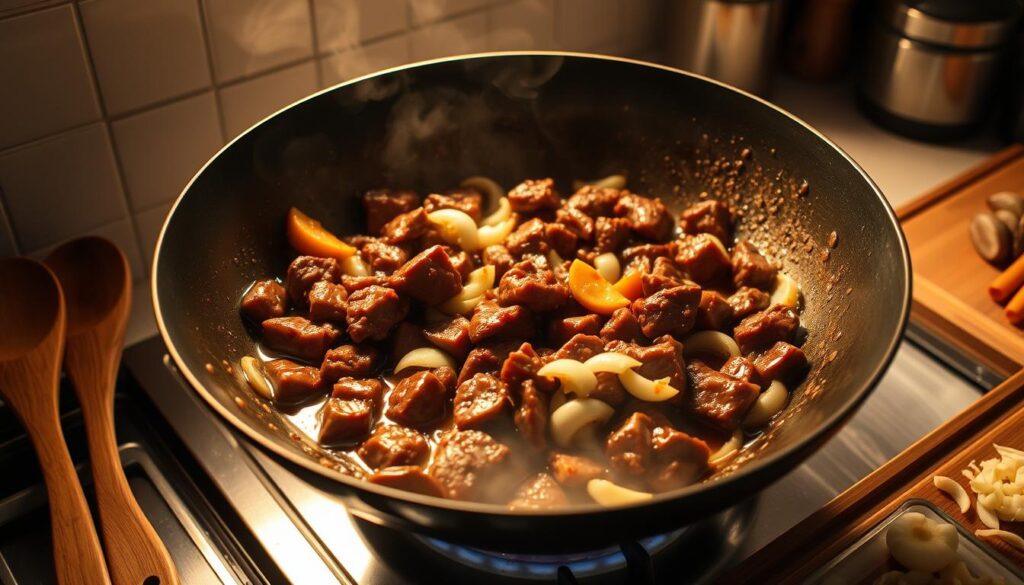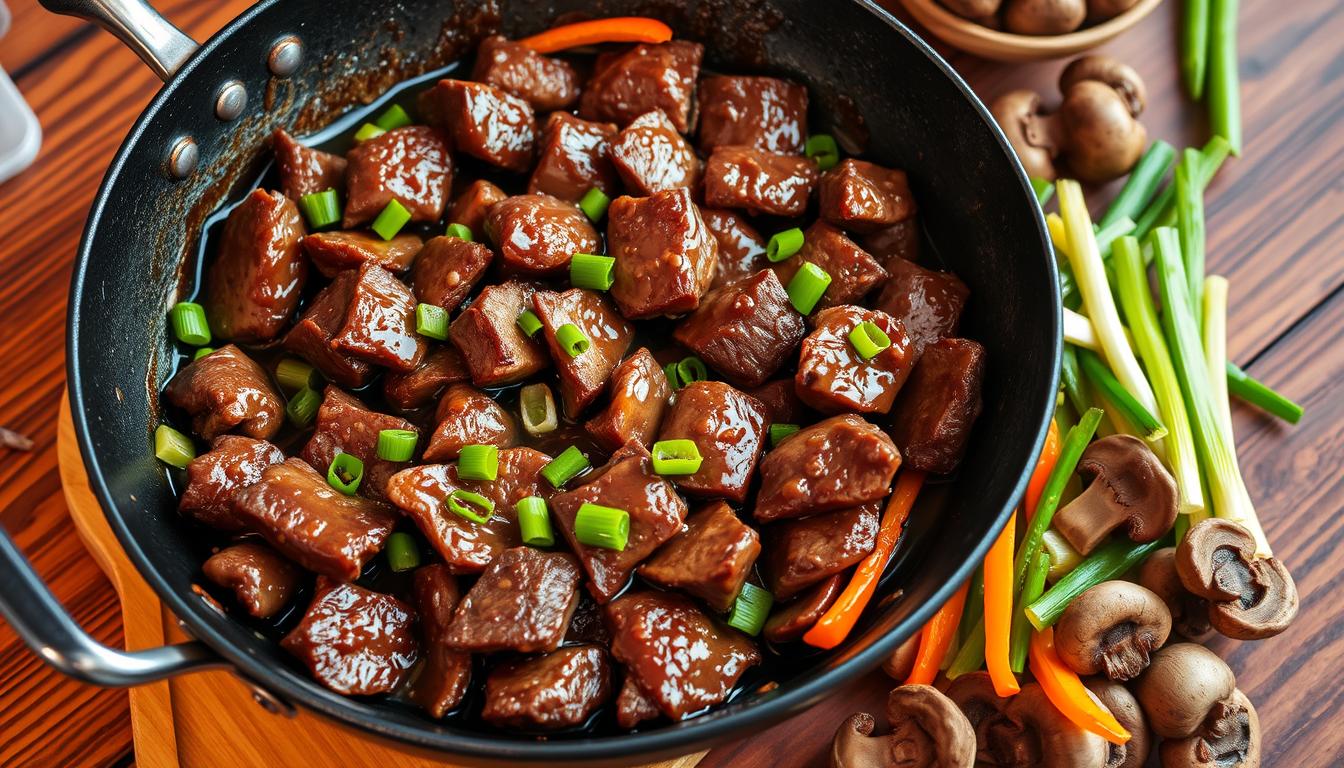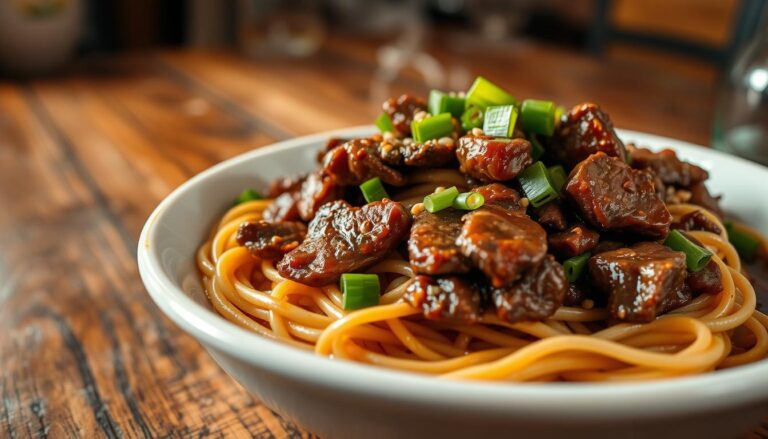Easy Mongolian Beef Recipe: Quick and Delicious
Craving takeout flavors without the wait? This restaurant-quality Mongolian beef recipe delivers bold taste in just 30 minutes. Perfect for busy weeknights, it combines tender slices of beef with a savory-sweet glaze that rivals your favorite Asian eatery.
You’ll love how simple this dish is to prepare. With common pantry ingredients like soy sauce, brown sugar, and garlic, you can skip the delivery app. The cooking process focuses on quick searing and simmering, ensuring maximum flavor without complicated steps.
What makes this recipe stand out? It balances crispy edges on the beef with a glossy, sticky sauce that clings to every bite. Serve it over steamed rice or noodles for a complete meal that feels indulgent yet effortless.
Key Takeaways
- Ready in 30 minutes with minimal prep work
- Uses accessible ingredients you likely already have
- Delivers authentic takeout flavor at home
- Features pro tips for achieving perfect texture
- Easily adaptable for spice lovers or dietary needs
Introduction to Quick Mongolian Beef
Discover how simple ingredients create a mouthwatering meal faster than delivery. This mongolian beef dish transforms flank steak into caramelized perfection using techniques anyone can master. The magic happens when thin beef slices meet a glossy sauce that balances sweet and savory notes.
Overview of the Recipe Concept
At its core, this recipe focuses on two elements: tender meat and bold flavor. You’ll quickly sear the beef over high heat to lock in juices, then simmer it in a garlic-infused glaze. Common pantry staples like soy sauce and brown sugar work together to create that signature sticky texture.
Why This Dish is Perfect for Weeknights
Busy cooks appreciate the 30-minute time commitment and minimal cleanup. Unlike fussy recipes, this version skips complicated steps without sacrificing taste. The high heat cooking method ensures your beef develops crispy edges while staying tender inside.
Perfect for last-minute dinners, this adaptable dish lets you swap vegetables or adjust spice levels. You’ll master restaurant-quality results using tools you already own – just a skillet and basic utensils. Now let’s explore how to choose the best ingredients for authentic flavor.
Essential Ingredients for Authentic Flavor
The secret to restaurant-worthy Mongolian beef lies in your ingredient selection. Every component works together like puzzle pieces – miss one, and the flavor profile changes completely. Let’s break down what makes this dish sing.
Choosing the Right Flank Steak and Vegetables
Flank steak reigns supreme for its bold beefy taste and quick-cooking nature. Look for bright red cuts with visible marbling – this fat melts during cooking, keeping your meat juicy. Slice it thinly against the grain for fork-tender results every time.
Onions add crunch and sweetness, but don’t stop there. Try adding bell peppers or snap peas for extra texture. The vegetables should complement, not overpower, the star ingredient.
Your sauce gets its magic from three key players:
- Low-sodium soy sauce controls saltiness while adding umami depth
- Dark brown sugar creates that glossy caramelized coating
- Fresh garlic cloves deliver aromatic punch without bitterness
Cornstarch acts as the unsung hero here. A single tablespoon mixed with water creates the sauce’s signature cling. Measure precisely – too much creates a gummy texture, while too little leaves your glaze watery.
Remember: accuracy matters. Use dry measuring cups for cornstarch and liquid ones for soy sauce to ensure perfect consistency. This attention to detail separates good Mongolian beef from exceptional versions you’ll crave repeatedly.
Preparing Your Beef and Vegetables
Perfect preparation transforms good ingredients into extraordinary meals. The way you handle your flank steak and veggies determines whether you’ll get chewy bites or melt-in-your-mouth tenderness.
Mastering Meat Preparation
Start by placing your flank steak flat on the cutting board. Identify the muscle fibers running lengthwise – this is the “grain.” Slice perpendicular to these lines using a sharp knife. Cutting against the grain shortens tough fibers, ensuring each piece stays tender after cooking.
Dust the sliced beef evenly with cornstarch. This coating creates a protective layer that seals in juices while promoting crispy edges. Shake off excess powder – you want a light, even dusting rather than a thick paste.
Heat your skillet until it sizzles when water droplets hit the surface. Cook in small batches to maintain high heat. Overcrowding steams the meat instead of searing it. Sear each batch for 90 seconds per side, then set aside to prevent overcooking.
Slice vegetables uniformly for even cooking. Onions and bell peppers work best when cut into ¼-inch strips. Keep veggie prep separate from meat until the final stir-fry stage to preserve distinct textures.
Crafting the Signature Sauce
The soul of Mongolian beef lies in its glossy, aromatic sauce that coats each slice perfectly. This liquid gold balances five essential flavors: sweet, salty, umami, tangy, and a subtle heat. Precision matters here – a single misstep in measurements could tilt the harmony.
Balancing Sweet, Savory, and Spicy Elements
Start with low-sodium soy sauce as your flavor foundation. Its salty depth anchors the mixture without overwhelming. Brown sugar steps in next, melting into caramel notes that counterbalance the saltiness. For every quarter-cup of soy sauce, use two packed tablespoons of sugar.
Fresh garlic cloves and grated ginger add aromatic complexity. Sauté them briefly to release oils before adding liquids. A splash of rice vinegar introduces brightness, while red pepper flakes bring adjustable heat. Whisk these ingredients cold to prevent clumping.
Simmer the mixture for 3-4 minutes after adding cornstarch slurry. Watch the transformation – the sauce thickens from watery to clingy as starch molecules expand. Test consistency by dragging a spoon through it; proper glaze should leave a temporary trail.
Adjust to taste after first simmer. Too sweet? Add soy sauce ½ teaspoon at a time. Need more kick? Sprinkle extra pepper flakes. Remember: the sauce intensifies when reduced, so under-season slightly initially. Your cooked beef will soak up flavors best when added to the simmering glaze.
Mastering High-Heat Cooking Techniques
Transform your kitchen into a steakhouse with professional searing methods. The right high heat approach creates caramelized crusts while keeping interiors juicy. Your large skillet becomes the hero tool here, conducting intense heat evenly across its surface.
Achieving a Crisp Seared Edge
Preheat your large skillet until water droplets dance and evaporate instantly. Add just enough oil to coat the bottom – about 1 tablespoon. This creates a sizzling barrier that locks in beef juices while developing crispy edges.
Cook in single-layer batches. Overcrowding the pan drops the temperature, steaming meat instead of searing it. Give each piece space to breathe. Flip after 90 seconds when edges turn golden brown.
Maintaining Moisture and Tenderness
Watch the clock like a hawk. Thin steak slices cook fast – 2-3 minutes total prevents toughness. Remove beef immediately when done, even if sauce isn’t ready. Residual heat continues cooking slightly.
Let meat rest 2 minutes before saucing. This pause allows juices to redistribute, ensuring every bite stays succulent. Pair your searing skills with precise timing for that ideal crisp-tender balance.
Step-by-Step Cooking Process

Ready to transform ingredients into restaurant-worthy Mongolian beef? Follow these foolproof steps:
1. Prep your station: Measure ¼ cup soy sauce and ½ cup water using liquid measuring cups. Coat sliced flank steak evenly with cornstarch – this creates crispy edges when seared.
2. Sear in batches: Heat 1 tbsp oil in a large pan over high heat. Cook beef in single layers for 90 seconds per side. Overcrowding steams meat – cook 3-4 batches, setting aside finished pieces.
3. Build the sauce: Reduce heat to medium. Sauté garlic until fragrant, then pour in soy sauce mixture. Add brown sugar and red pepper flakes. Simmer 2 minutes until slightly thickened.
4. Combine elements: Return all beef to the pan. Toss vigorously to coat each piece. Cook 1 minute – the sauce will cling like glossy armor. Remove from heat immediately to prevent overcooking.
5. Serve hot: Plate over steamed rice within 5 minutes of finishing. Garnish with sliced green onions for freshness. This process ensures tender beef with that signature sticky-sweet coating.
Pro tip: Use separate measuring cups for dry and liquid ingredients. Precision with soy sauce and water ratios guarantees perfect sauce consistency every time. Working in batches might add 3 extra minutes, but delivers superior texture worth the effort.
easy-mongolian-beef-30-minute-recipe: Tips and Tricks
Master restaurant-quality Mongolian beef by sidestepping these common kitchen mistakes. While the recipe seems straightforward, a few adjustments ensure perfect results every time. Let’s explore solutions to frequent challenges home cooks face.
Avoiding Common Cooking Pitfalls
Overcrowding your skillet ranks as the top texture killer. Cook beef in single layers using 1 tablespoon oil per batch. This maintains high heat for proper searing instead of steaming. If pieces stick, wait 30 seconds – they’ll release naturally when properly browned.
Select crisp green onions with vibrant stalks. Slice them diagonally for maximum surface area to absorb flavors. For regular onions, cut uniform wedges that cook evenly. Always add vegetables last to retain their crunch.
Boost flavor by toasting sesame seeds or adding orange zest to the sauce. Many votes from our readers confirm these tweaks elevate the dish. For richer depth, substitute 1 teaspoon dark soy sauce in your glaze mixture.
Let the meat rest 2 minutes after cooking before tossing with sauce. This prevents the cornstarch coating from becoming gummy. Remember: success lies in balancing speed and precision – measure ingredients before heating your pan to save time.
Serving Suggestions and Delicious Pairings
Transform your Mongolian beef into a complete feast with smart pairings that elevate every bite. The dish’s rich glaze and tender meat shine brightest when balanced with complementary textures and flavors. Let’s explore how to build a vibrant plate that delights all senses.
Perfect Rice and Vegetable Sides
Steamed rice acts as the ideal canvas for soaking up that glossy sauce. Opt for jasmine or basmati varieties – their floral notes enhance the savory beef. For a nuttier profile, try brown rice cooked with a dash of sesame oil.
Brighten your plate with fresh garnishes. Thinly sliced green onions add peppery crunch and pops of color. Sprinkle toasted sesame seeds for extra texture, or add chili threads if you enjoy heat.
Round out your meal with these crowd-pleasing sides:
- Stir-fried bok choy with garlic and a splash of soy sauce
- Quick-pickled carrots and daikon radish for tangy contrast
- Steamed broccoli tossed with lemon zest and black pepper
Experiment with different recipes to keep meals exciting. Try wrapping beef and rice in lettuce cups for handheld fun, or serve alongside crispy vegetable spring rolls. The beauty of this dish lies in its versatility – let your taste buds guide the adventure.
Nutritional Information and Recipe Variations
Understanding the balance between flavor and nutrition makes this Mongolian beef recipe both satisfying and smart. A typical serving (1 cup with rice) contains approximately 380 calories, with 28g protein from lean steak and 12g fat from cooking oil. The dish delivers 45% of your daily iron needs while keeping carbs around 32g per portion.
Understanding Flavor and Health Benefits
Choose sirloin steak instead of flank for lower fat content without sacrificing tenderness. Garlic and ginger add more than just aroma – these ingredients boost immunity with natural antioxidants. Reduce sodium by using low-sodium soy sauce, which still provides that essential umami kick.
Customize the recipe to fit dietary needs:
• Swap regular soy sauce for tamari to make it gluten-free
• Use coconut sugar instead of brown sugar for lower glycemic impact
• Double the ginger and add chili paste for extra heat lovers
Vegetarians can substitute portobello mushrooms for beef – their meaty texture absorbs the sauce beautifully. For quicker prep, slice vegetables while the steak marinates in cornstarch. Always cook in a hot pan to seal in juices and maintain nutritional value.
Adjust portion sizes to meet specific calorie goals. Pair with cauliflower rice instead of white rice to cut carbs by 15g per serving. Remember: small tweaks create big changes without losing the dish’s signature sticky-sweet appeal.
Conclusion
Your kitchen now holds the power to outshine takeout with this Mongolian beef recipe. Thinly sliced steak seared to crispy perfection, combined with that sticky-sweet glaze, proves gourmet meals needn’t take hours. Remember: slicing against the grain and high-heat cooking transform tough cuts into tender bites.
Keep this recipe handy for busy nights – it’s faster than delivery. Print it or bookmark the page for instant access. Leftovers reheat beautifully in a skillet over medium heat. Serve with steamed rice and a garnish of green onions for freshness.
Now’s your moment to shine. Whip up this Mongolian beef in 30 minutes and taste the difference homemade makes. Share your success stories using #BetterThanTakeout – we’d love to see your twist on this classic. Your next favorite beef dish starts here, at home.
FAQ
Can I use a different cut of beef if I don’t have flank steak?
Yes, you can substitute flank steak with skirt steak, sirloin, or ribeye. Slice the meat thinly against the grain for tender results, as these cuts may require slightly adjusted cooking times.
Is low-sodium soy sauce a good substitute for regular soy sauce?
Absolutely. Low-sodium soy sauce works well if you’re watching salt intake. Adjust seasoning to taste, as the sauce’s savory balance relies on soy sauce’s umami depth.
How do I prevent the beef from becoming tough?
Toss sliced flank steak in cornstarch before cooking. This creates a light coating that locks in moisture during high-heat searing. Avoid overcrowding the skillet to ensure crisp edges without overcooking.
Can I make this dish gluten-free?
Yes! Swap regular soy sauce for tamari or a certified gluten-free soy sauce. Double-check labels on brown sugar and other ingredients to ensure compliance.
What’s the best way to store leftovers?
Store cooled Mongolian beef in an airtight container in the fridge for up to 3 days. Reheat gently in a skillet or microwave, adding a splash of water to refresh the sauce.
How can I adjust the sauce’s sweetness or spice level?
Reduce brown sugar for less sweetness or add red pepper flakes for heat. Taste the sauce as you cook and tweak ratios of soy sauce, ginger, or garlic to suit your preferences.
Do I need a wok, or can I use a regular skillet?
A large skillet works perfectly. High heat is key for searing the beef quickly. If using a nonstick pan, ensure it’s rated for high temperatures to avoid damaging the coating.
What sides pair well with Mongolian beef?
Serve with steamed jasmine rice, fried rice, or cauliflower rice. Stir-fried broccoli, snap peas, or sliced bell peppers add freshness and crunch to balance the rich sauce.







